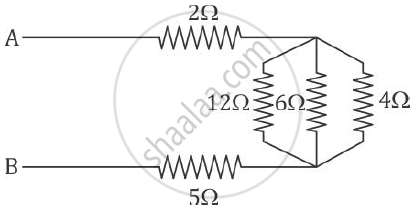Advertisements
Advertisements
Question
In the circuit shown below, calculate the equivalent resistance between the points (i) A and B, (ii) C and D.
Solution

(i) Between the points A and B : Three resistance 2 Ω, 2Ω, 2Ω are in series.
The equivalent resistance R' = 2 + 2 + 2 = 6 Ω
This is joined in parallel with a resistance 2Ω
The equivalent resistance R = `(2 xx 6)/(2 + 6) = 12/8 = 15. Omega`
(ii) Between the points C and D:
The above combination of equivalent resistance 1.5 Ω is in series with two resistances 2Ω and 2Ω
Total effective resistance between the points C and D is R
= 1.5 + 2 + 2 = 5.5
APPEARS IN
RELATED QUESTIONS
Find the equivalent resistance between points A and B.

Two resistors of 4Ω and 6 Ω are connected in parallel to a cell to draw 0.5 A current from the cell.
(i) Draw a labelled circuit diagram showing the above arrangement.
(ii) Calculate the current in each resistor. What is an Ohmic resistor?
What is the equivalent resistance between A and B in the given circuit (Fig?)

You have three resistors of values 2 `Omega`, 3 `Omega`, and 5 `Omega`. How will you join them so that the total resistance is less than 2 `Omega`?
State the effect of rise in temperature on the resistance of semi-conductors.
How does the resistivity of a semiconductor depend on temperature?
State expression for Cells connected in parallel.
Two lamps of resistance 30Ω and 20Ω respectively are connected in series in a 110V circuit. Calculate:
(i) the total resistance in the circuit
(ii) the current in the circuit, and
(iii) the voltage drop across each lamp.
Calculate the value of the resistance which must be connected to a 15 ohm resistance to provide on effective resistance of 6 ohm.
